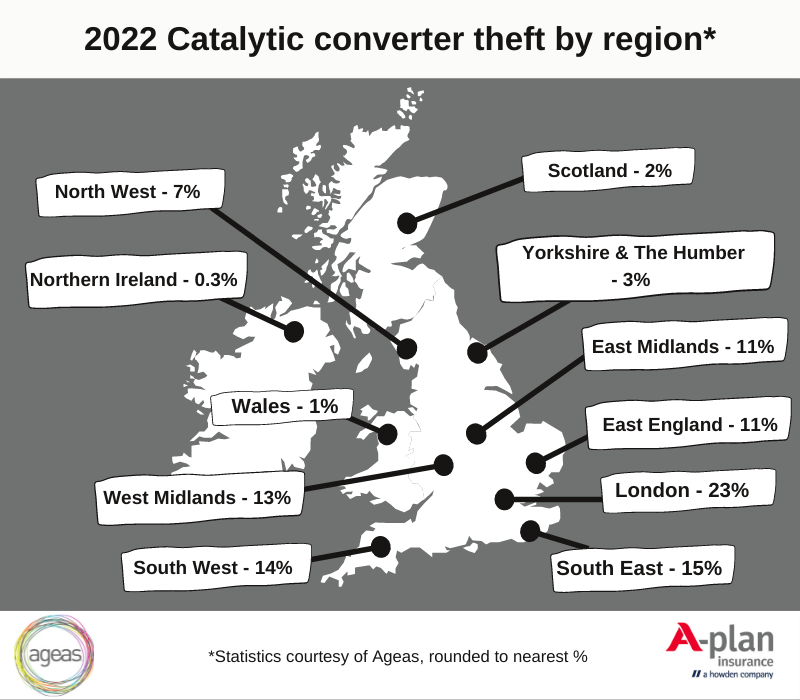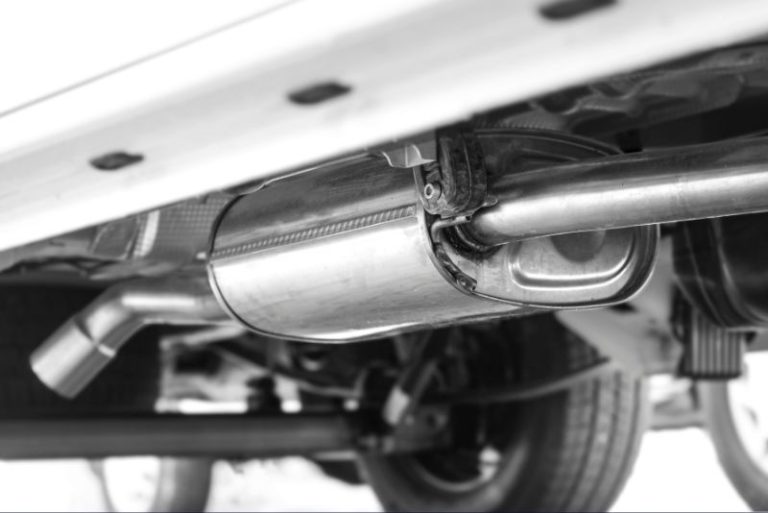We have continually reported on and raised awareness of the rise in catalytic converter thefts and how owners can protect their vehicle – the latest figures show the situation as seen by our friends at Ageas.
Before we review the latest information, here’s a summary of how thieves have been targeting catalytic converters in London, in particular, over the past 5 years:
Catalytic converter theft in London
MoneySupermarket’s earlier survey illustrated that theft of catalytic converters in London had increased from just 154 to 12,482 thefts over a 3-year period. In total, from 2017 to 2020, London-based catalytic converter thefts totalled over 15,000.
Following that, a 2021 update by the Metropolitan Police, illustrated that in 2021 alone, over 10,000 catalytic converter thefts were recorded, by police, in London.
In 2022, most catalytic converter claims still occur in London, however, things are changing…
Catalytic converter theft in 2022
New statistics provided by A-Plan Insurance panel partners, Ageas, illustrates some good news. And some bad news.
The good news is that it appears that catalytic converter theft volumes peaked in late 2020 and early 2021 and have since reduced. There are many thoughts around this, including the fact that, with so many of us at home during the pandemic, it was much harder to break into houses, as opposed to a vehicle on a driveway.
The picture seen by Ageas confirms that the London area still contains the most catalytic converter thefts, however this has dropped from 34% of claims in 2019 to 23% in 2022.
The bad news is that Ageas reports an increase in catalytic converter theft claims in other areas, including the South West, West Midlands, the North West.

Who buys stolen catalytic converters?
Stolen catalytic converters are sold to rogue scrap and parts dealers.
The rise in thefts of catalytic converters is in line with the rise in the value of materials, which incorporates platinum, making catalytic converter theft a lucrative business for gangs to sell the precious metals on the black market.
Facebook has been criticised for allowing scrap dealers to advertise a buying price for stolen catalytic converters, and subsequently removed the offending posts, however there is still a market for this online.
More needs to be done to ensure each catalytic converter sale is traceable, and rogue scrap dealers – and the gangs that supply them – are held responsible.
This rise in catalytic converter theft has seen a call for greater punishment for the criminal gangs involved, with only 42 individuals prosecuted for catalytic converter theft between 2017 and 2020.
Which cars are the most targeted for catalytic converter theft?
The reality is that any vehicle with a catalytic converter is at risk.
However, diesel catalytic converters also have significantly lower value, while fully-electric vehicles don’t use catalytic converters at all.
Additionally, any vehicles with little ground clearance are less at risk – if a thief can’t get underneath it, they can’t steal it.
Signs of a stolen catalytic converter
A common question is ‘how do I know if my catalytic converter has been stolen?’. If you’re not mechanically minded, it’s a fair question.
- Your vehicle will be noticeably louder.
- Your engine warning light will be on.
- You may get a headache – a stolen catalytic converter exposes you to 20 times more carbon monoxide.
- Looking under the vehicle, you will see unmistakable clean cut marks where it was removed.
Catalytic converter anti-theft devices
This video, shared by the Metropolitan Police, illustrates a catalytic converter being stolen in 60 seconds:
Fit your catalytic converters with locks or guards – although theft is still possible even with these devices in place, it does increase the time is takes to remove one from under a minute to around 25 minutes!
In addition to that, mark your catalytic converter with forensic markers, such as the one by SmartWater. The ‘SmartTrace‘ solution is simply painted on to the catalytic converter and SmartWater scientists only need a speck of the solution to identify the vehicle it came from, much like DNA analysis, which provides traceability even when broken down for parts.
With a major operation launched last year, codenamed ‘Goldiron’, police advice includes parking in a locked garage, where possible, near walls or other vehicles to make it harder for thieves to get underneath the vehicle.
Manufacturers like Toyota are now working with the police to create a National Database of Catalytic Converters, with the aim of making Toyota and Lexus models ‘untouchable’ by making all catalytic converters traceable.
Is catalytic converter theft covered by car insurance?
Yes, under the theft section of your car insurance policy. Depending on your insurers criteria, you may need to file a police report in the first instance.
Your premiums may increase as a result of the claim, however the ‘how much?’ will be down to a number of factors, including previous claims. Another thing to consider is the rising costs of the parts could make a lower-valued vehicle uneconomical to repair!
Claiming for this type of crime will also affect your No Claims history, so if your vehicle is in the ‘at risk’ category, it is worth considering protecting your No Claims Discount now. It doesn’t prevent your premium from going up, but it will ensure that you get the maximum No Claims Discount on it when it does.
According to Which? victims have reported repair quotes of over £1,200 in their recent survey, with 27% electing to settle the bill privately as opposed to an increased car insurance premium or, in the case of older vehicles, it being written off entirely.
If you have any questions, or are a victim of catalytic converter theft and not sure where to start – contact your local A-Plan branch for advice.
Whether you witness a crime in action, or are a victim of catalytic converter theft, always contact the police in the first instance.

